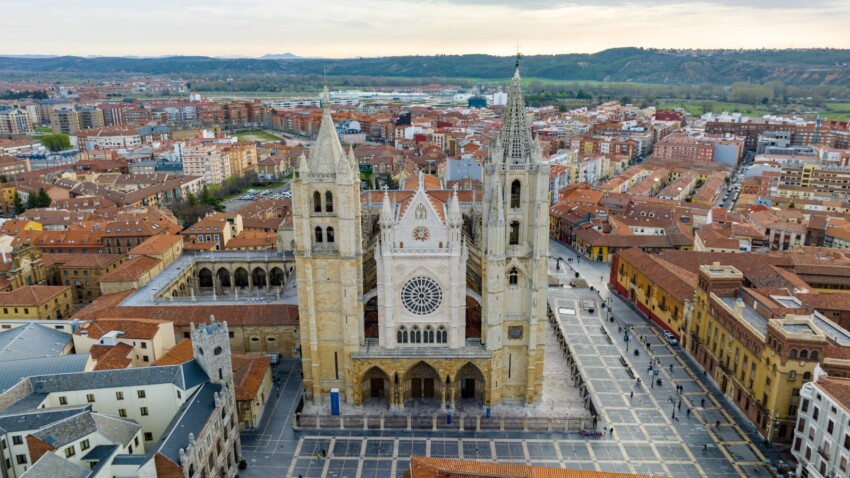

A city with an ancient and glorious past, León is now a small town in Spain known not only for its many monuments and sites but also for being a stop on the famous Camino de Santiago and the starting point of the San Salvador route.
The history of León is very important not only for the city itself but also for the whole of Europe. During the Roman Empire this town was founded as a control point on the route to the mines in the northwest, but later became the military capital of Hispania Romana. Part of the walls from those times can still be seen next to the medieval one.
León managed to maintain an ‘independent’ city status during the barbarian invasions but then fell into the hands of the Arabs. In 910, however, the city saw the birth of the Kingdom of León, one of the most important kingdoms in medieval Europe. It was here, in fact, that the ‘Cortes’ were born, an early form of parliament that included representatives of the nobles, people and clergy who met together with the king to discuss important decisions. Few people know that León had its own parliament until the 14th century and minted its own currency until the Renaissance.
Nowadays, the city presents itself as an important tourist centre that attracts not only visitors curious to learn more about the city and history enthusiasts, but also pilgrims and adventurers who are embarking on the Pilgrim’s Way to Santiago or the Pilgrim’s Way to San Salvador. In addition, León ‘s location on the southern slope of the Cantabrian Mountains between the Bernesga and Torío rivers makes this city the perfect destination for a stay in contact with nature.
The historical centre of León is a treasure chest that has managed to preserve testimonies and sites from the different historical periods that the city has faced. From Romanesque walls to medieval squares, from Gothic to Renaissance masterpieces: León is a city that has much to offer its visitors. The Old Town is the oldest area and has managed to preserve its medieval appearance. The centre is divided into two zones by the Calle Ancha: to the south is the Barrio Húmedo (or Barrio de San Martin) where numerous clubs, pubs and discos can be found, while to the north is the Romantic Quarter where numerous restaurants and large hotels can be found.
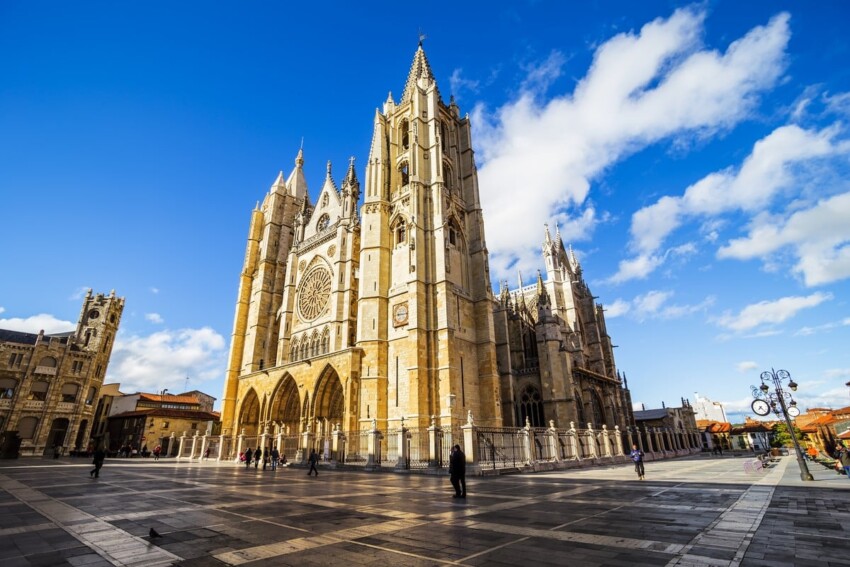
The Cathedral of León is a Gothic-style masterpiece reminiscent of French cathedrals. Originally there were Roman baths on this site, which were converted into a royal palace by Ordoño II in the 10th century. In the 12th century, however, the land was donated to the Church to build the city cathedral on this site. The layout of the cathedral is reminiscent of that of the cathedral in Reims and is in the shape of a Latin cross with three naves separated by tall, slender pillars and cross vaults.
Its façade boasts two towers on either side, the Bell Tower and the Clock Tower, which are 65 and 68 metres high respectively. In total there are three portals and the central one, which is the main one, houses a copy of the image of the White Virgin, the original version of which can be found inside. Inside you can admire a unique collection of 125 stained glass windows and a valuable choir stalls, whose stalls are considered the oldest in Spain.
The Walls of León delimit what is now known as the Old Town, an area of Roman origin that also preserves several testimonies of the medieval period. The city walls of León are considered to be one of the oldest preserved in Spain and, although they are not complete, they remain an excellent example of fortification from the Roman period. The remaining sections have allowed us to understand that the old town once had a peculiar quadrangular plan. Since 1931, the city walls have been part of the list of Historical and Artistic Monuments of Spain.
The Plaza Mayor is the heart of León’s social life. This 17th century arcaded square, with its characteristic Mirador building, is the place where the city’s main events take place. Its bars and restaurants offer the opportunity to enjoy the famous León gastronomy and participate in the tapas tradition.
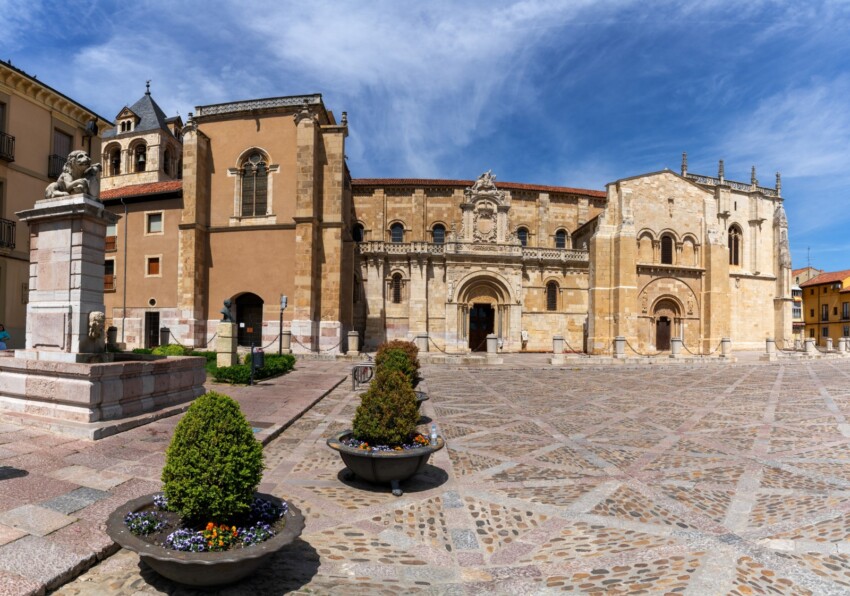
This Romanesque church dedicated to Saint Isidore was erected on the site of a former Roman temple dedicated to Mercury. What we can see now is the result of several renovations that have altered the original appearance.
The building is in pre-Romanesque-Asturian style with three naves inside and a valuable series of frescoes that has earned it the name ‘Sistine Chapel’ of the Romanesque period.
Next to the Basilica is the Pantheon of Kings, a burial monument for sovereigns that is considered one of the oldest in Spain. Here lie the remains of the kings of León and other members of the León court.
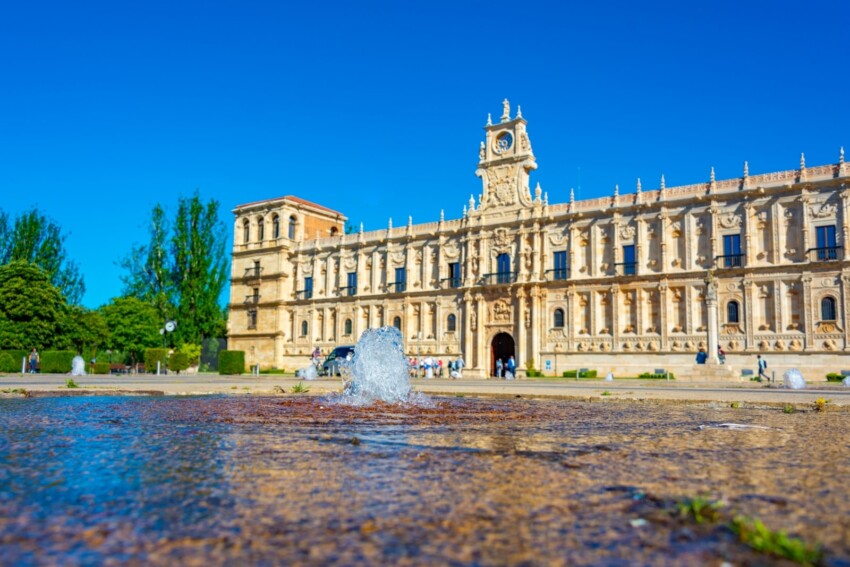
The Monastery of San Marcos de León was built between the 16th and 18th centuries as a convent that was intended to accommodate pilgrims who decided to undertake the Pilgrim’s Way to Santiago. In reality, this complex has now evolved and comprises three areas: a hostel, the church and a museum.
The museum houses masterpieces and paintings of the Flemish school, various pieces of furniture salvaged from churches and old houses, tapestries and wood carvings. Contemporary artists whose works are exhibited in the museum include Lucio Muñoz, Vela Zanetti, Álvaro Delgado and Severo Ocho.
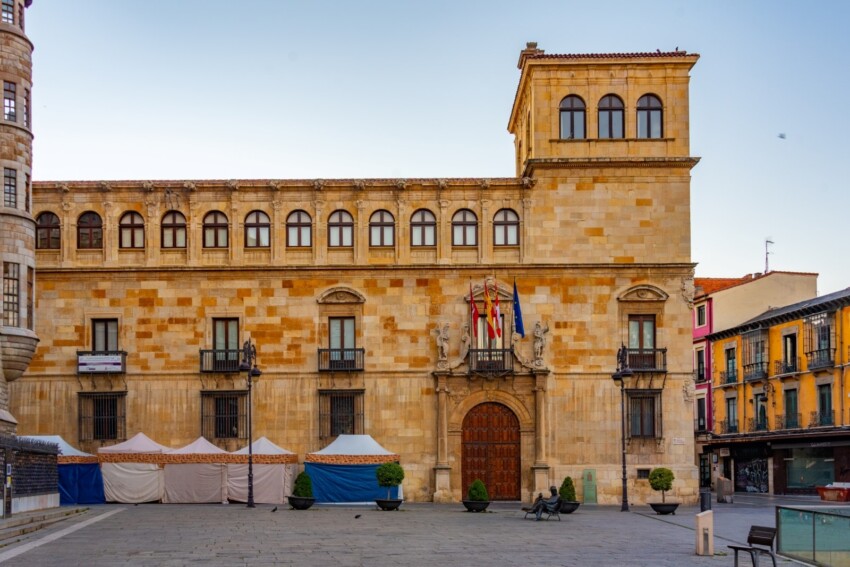
The Palacio de los Guzmanes is a building commissioned by Juan Quiñones y Guzmán, Bishop of Calahorra. The Guzmanes family was one of the most influential and powerful families in León, apparently originating from Brittany. Construction work began in 1560 under the supervision of Rodrigo Gil de Hontañón.
Observing from the outside, one can see that its façade has two orders. On the ground floor you can admire the finely decorated 16th century main door, flanked by Ionic columns and surmounted by statues of two soldiers with the Guzmanes family crest. Just above the main entrance is the presidential balcony. The inner courtyard, which is surrounded by an arcaded loggia, is also very interesting.
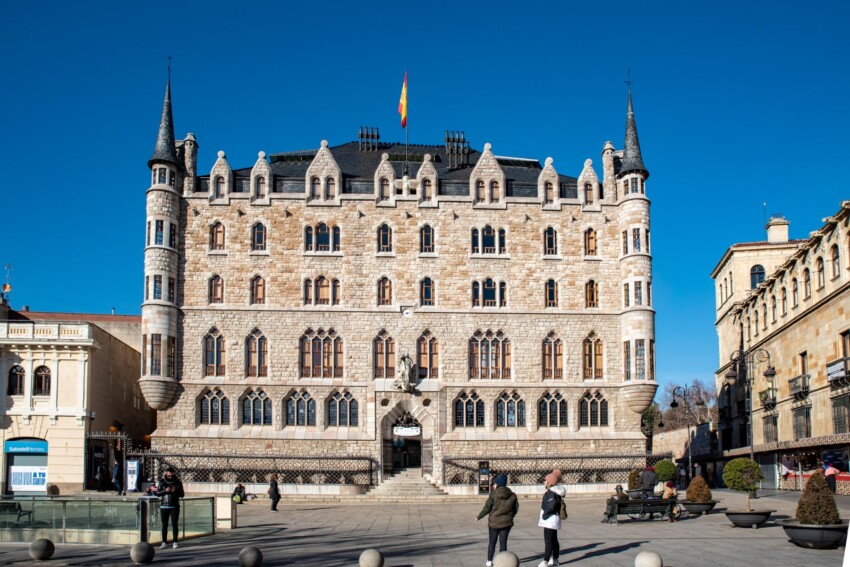
The Casa de los Botines, also known as Casa Fernández y Andrés, is one of the few works that the architect Antonio Gaudí built outside Catalonia. The house is a building constructed between 1891 and 1894 in a neo-Gothic style but with modern influences. The building has 4 floors with the first floor being dedicated to the owners, while the upper floors were for rent.
The main entrance is surmounted by a stone sculpture of St. George slaying the dragon with a lance. In 1950 during some restoration work on the statue, original plans signed by Gaudí were discovered inside the sculpture. In front of the house stands on a bench a bronze sculpture by José Luis Fernández depicting Gaudí sitting while reading.
In the following map you can see the location of the main places of interest mentioned in this article.
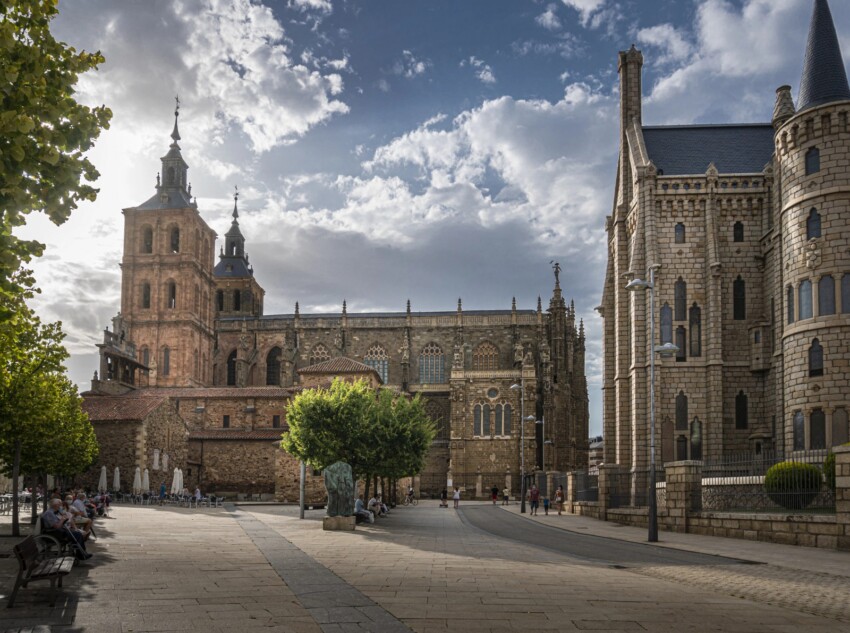
León’s location makes it easy to explore some of the most interesting parts of the province. Hiring a car is recommended for maximum flexibility.
Las Médulas, a UNESCO World Heritage Site, is an ancient Roman gold mine that has created a spectacular landscape of reddish peaks and lakes. Located 140 km from León, it offers well-marked hiking trails and an interpretation centre that explains Roman mining techniques.
The city of Astorga, 45 km from León, is famous for its Episcopal Palace designed by Gaudí and its Gothic cathedral. The city, an important stop on the Pilgrim’s Way to Santiago, is also known for its artisanal chocolate and traditional sweets.
The picturesque village of Castrillo de los Polvazares, 50 km from León, is one of the best preserved in the region. Its traditional stone houses and its famous ‘cocido maragato’ (typical dish) make it a must-see for lovers of gastronomy and traditional architecture.
The Valdeón Valley, in the heart of the Picos de Europa National Park, offers spectacular mountain landscapes and the chance to taste the famous Valdeón cheese. The area is perfect for trekking and wildlife watching.
The historical centre of the city of León is famous for having a large hotel and accommodation offer. Being a stopover on the Camino de Santiago, here you will not only find large hotels and inns but also numerous hostels. The area in the centre is definitely the best place to stay, as here you will also find a large number of inns, restaurants, taverns and tapas bars where you can enjoy the local gastronomy.
The Santa Ana district, just outside the historical centre, is a good alternative for those looking for more modern and quiet accommodation, while remaining within a few minutes’ walk of the main attractions.
León enjoys a strategic location as it is bordered by seven provinces of four autonomous communities and is the main communication route with the regions of Asturias and Galicia. This city is served by an excellent road network that includes state roads, motorways and ring roads that connect it with other important locations in the country.
By car, it is possible to reach León from the south of Spain by first taking the A-6 motorway (Madrid – A Coruña) and then the A-66 motorway. From the north of Spain it is possible to reach León by the Huerna AP-66 motorway, and from the west by taking the A-6 motorway to Astorga and then the AP-71. Those coming from the east can take the A-231 motorway to Burgos.
Those who want to reach the city by bus can use the lines of the ALSA company, which offers connections to most provincial capitals in the north of Spain. Through its lines it is possible to reach León from Zaragoza, Barcelona, Alicante, Benidorm, Bilbao, Vigo, Coruña, Lugo, Santander, Valladolid, Oviedo and Madrid.
The train is also one of the easiest ways to reach León from anywhere in Spain. The city has the Adif station, which is located right next to the historical centre. Train lines connect León with important cities in Spain such as Madrid, Barcelona, Vigo, La Coruña, Alicante and Gijón.
Approximately 6 km from the city is also the León airport (Aeropuertu de Llión), which provides connections with major cities in Spain such as Madrid, Barcelona and Valencia, as well as in Europe such as Paris and Berlin.
What's the weather at León? Below are the temperatures and the weather forecast at León for the next few days.
León is located at the north-western end of the Autonomous Community of Castilla y León, a region in north-central Spain. The city is 140 km from Valladolid, 180 km from Burgos and 310 km from Santiago de Compostela.